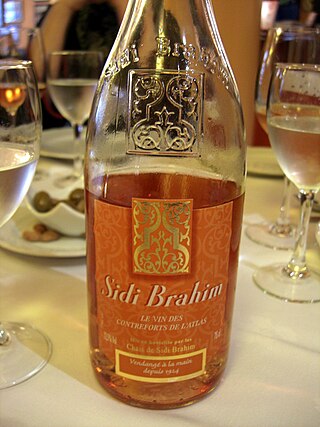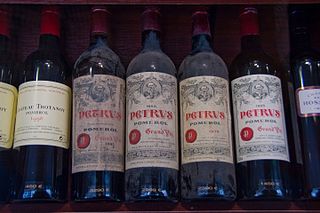
Château Mouton Rothschild is a wine estate located in the village of Pauillac in the Médoc region, 50 km (30 mi) north-west of the city of Bordeaux, France. Originally known as Château Brane-Mouton, its red wine was renamed by Nathaniel de Rothschild in 1853 to Château Mouton Rothschild. In the 1920s it began the practice of bottling the harvest at the estate itself, rather than shipping the wine to merchants for bottling elsewhere.

Graves is an important subregion of the Bordeaux wine region. Graves is situated on the left bank of the Garonne River, in the upstream part of the region, southeast of the city Bordeaux and stretches over 50 kilometres (31 mi). Graves is the only Bordeaux subregion which is famed for all three of Bordeaux' three main wine types—reds, dry whites and sweet wines—although red wines dominate the total production. Graves AOC is also the name of one Appellation d'origine contrôlée (AOC) which covers most, but not all of the Graves subregion.

Château Latour is a French wine estate, rated as a First Growth under the 1855 Bordeaux Classification. Latour lies at the very southeastern tip of the commune of Pauillac in the Médoc region to the north-west of Bordeaux, at its border with Saint-Julien, and only a few hundred metres from the banks of the Gironde estuary.

Château Margaux, archaically La Mothe de Margaux, is a wine estate of Bordeaux wine, and was one of five wines to achieve Premier cru status in the Bordeaux Classification of 1855. The estate's best wines are very expensive, with a bottle of Château Margaux grand vin reaching over $1,000. The estate is located in the commune of Margaux on the left bank of the Garonne estuary in the Médoc region, in the département of Gironde, and the wine is delimited to the AOC of Margaux.
Beer in Africa, especially lager, is produced commercially in most African countries, and indigenous people also make varieties of beer. Beer is served in various locales, from neighbourhood shebeens to upscale bars. Many countries have standardized beer bottle sizes, which are cleaned and re-used, so when buying beer at a store, people often must pay a deposit on the bottle and the price of the beer. An alternative to glass-bottle beers is local beer sold in tetra-pak style paper cartons.

Bordeaux wine is produced in the Bordeaux region of southwest France, around the city of Bordeaux, on the Garonne River. To the north of the city, the Dordogne River joins the Garonne forming the broad estuary called the Gironde; the Gironde department, with a total vineyard area of 110,800 hectares, is the second largest wine-growing area in France behind the Languedoc-Rousillon.

French wine is produced all throughout France, in quantities between 50 and 60 million hectolitres per year, or 7–8 billion bottles. France is one of the largest wine producers in the world, along with Italian, Spanish, and American wine-producing regions. French wine traces its history to the 6th century BCE, with many of France's regions dating their wine-making history to Roman times. The wines produced range from expensive wines sold internationally to modest wines usually only seen within France such as the Margnat wines of the post-war period.
Château Lascombes is a winery in the Margaux appellation of the Bordeaux region of France. The wine produced here was classified as one of fifteen Seconds Crus in the original Bordeaux Wine Official Classification of 1855. In the 1950s, the estate was purchased by French wine writer Alexis Lichine who continued to own part of the estate till 1971 when Bass Charrington took over principal ownership. In 2001 it was purchased by Yves Vatelot and US-based Colony Capital, who in 2011 sold it to the French insurance group MACSF. In addition to its premier cuvee, a second wine is also produced, under the name Chevalier de Lascombes. Additional brands are Château Segonnes, Rosé de Lascombes, Vin Sec Chevalier de Lascombes and Gombaud.
Les Sociétés Anonymes des Brasseries du Cameroun is a brewing company in Cameroon. Their offices and main factory are in Douala, with other breweries in Bafoussam, Douala, Garoua, and Yaoundé. Les Brasseries et Glacieres Internationales (BGI) owns a 75% share in the company, and Heineken owns 8.8%.

The wine regions of Bordeaux in France are a large number of wine growing areas, differing widely in size and sometimes overlapping, which lie within the overarching wine region of Bordeaux, centred on the city of Bordeaux and covering the whole area of the Gironde department of Aquitaine.

In the Bordeaux wine region there are seven regional Appellations d'origine contrôlée (AOCs) that may be used throughout the Gironde department. These are Bordeaux Rouge AOC, Bordeaux Supérieur Rouge, Bordeaux Clairet, Bordeaux Rosé, Bordeaux Blanc, a dry white, Bordeaux Supérieur Blanc, a sweet white, and Crémant de Bordeaux, a sparkling méthode traditionnelle wine. The regional appellations together form the largest world-class wine vineyard, making up more than half of the production of the prestigious Bordeaux wine region, and representing more than 55% of all Bordeaux wines consumed in the world.
Château Rieussec is a sweet white wine ranked as Premier Cru Classé in the original Bordeaux Wine Official Classification of 1855. Belonging to the Sauternes appellation in Gironde, in the region of Graves, the winery is located in the commune of Fargues.
Médoc is an AOC for wine in the Bordeaux wine region of southwestern France, on the Left Bank of the Gironde estuary that covers the northern section of the viticultural strip along the Médoc peninsula. The zone is sometimes called Bas-Médoc, though this term is not permitted on any label. With few exceptions there is produced only red wine, and no white wine has the right to be called Médoc.

Château Smith Haut Lafitte is a Bordeaux wine from the Pessac-Léognan appellation, ranked among the Crus Classés for red wine in the Classification of Graves wine of 1953 and 1959. The winery and vineyards are located south of the city of Bordeaux, in the commune of Martillac.

South West France, or in French Sud-Ouest, is a wine region in France covering several wine-producing areas situated respectively inland from, and south of, the wine region of Bordeaux. These areas, which have a total of 16,000 hectares of vineyards, consist of several discontinuous wine "islands" throughout the Aquitaine region, and more or less to the west of the Midi-Pyrénées region.

Sidi Brahim is a range of branded wines produced in the Atlas Mountains, first in Algeria, then in Morocco and now in Tunisia. The wines are blended and bottled or filled into bag-in-boxes in France, and are primarily sold there. It was the second-best selling foreign wine in France, behind Boulaouane, as of 2005. The production volume is around three million bottles annually. The wine has been named after the Battle of Sidi-Brahim (1845).

Pomerol is a French wine-growing commune and Appellation d'origine contrôlée (AOC) within the Libournais in Bordeaux. The wine produced here is predominately from Merlot with Cabernet Franc playing a supporting role. Unlike most other Bordeaux communes, there is no real village of Pomerol, although there is a church. The houses are set among the vineyards.

Saint-Estèphe is an Appellation d'Origine Contrôlée (AOC) for red wine in the Bordeaux region, located in the Médoc subregion. It takes its name from the commune of Saint-Estèphe and is the northernmost of the six communal appellations in Médoc. Five classified growths of 1855 are located within the appellation area. Saint-Estèphe has held AOC recognition since 1936.

Blaye is a wine region in Bordeaux, centred on the town of Blaye, producing both red and white wine, plus a small amount of rosé and sparkling wine. It is located on the right bank of the River Gironde, and surrounds Côtes de Bourg.

Among the countries of North Africa, Morocco is considered to have the best natural potential for producing quality wines, due to its high mountains and the cooling influence of the Atlantic, as these factors offset the risk of having too hot vineyards. An important exporter of wine in the colonial era between 1912 and 1955, the Moroccan wine industry is experiencing a revival and expansion since the 1990s due to influx of foreign investments.













